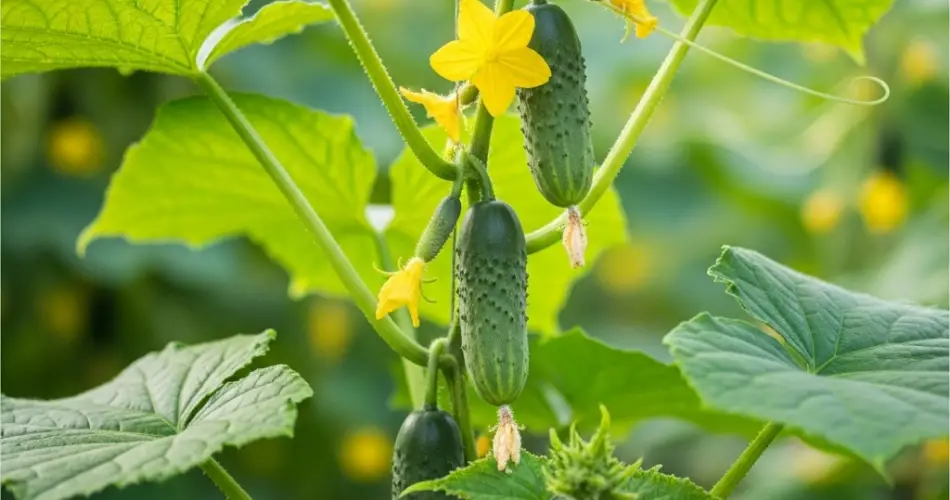You don’t need a sprawling backyard to enjoy the satisfaction of growing and harvesting your own cucumbers. With the right approach, even apartment dwellers can grow crisp, refreshing cucumbers right on a windowsill, balcony, or compact patio space. Container gardening has made it easier than ever to raise vegetables in small urban settings, and cucumbers—fast-growing, productive, and delicious—are an ideal choice.
Here’s a complete guide on how to plant, nurture, and harvest cucumbers indoors or in tight spaces, so you can enjoy a steady supply of fresh produce no matter where you live.
Choose the Right Cucumber Variety
Not all cucumbers are suited for container gardening, especially in small spaces. When growing indoors or on a balcony, it’s best to choose bush or compact cucumber varieties rather than sprawling vining types.
Look for varieties labeled:
-
‘Bush Pickle’
-
‘Spacemaster’
-
‘Patio Snacker’
-
‘Salad Bush’
These types are specifically bred to grow well in confined spaces and don’t require as much vertical support.
Prepare the Ideal Growing Container
Cucumbers need room to grow a strong root system, so choose a container at least 12 inches deep and wide. Make sure it has drainage holes to prevent waterlogging, which can lead to root rot.
You can use:
-
Plastic or clay pots
-
Grow bags
-
Rectangular planters
Fill your container with a well-draining potting mix rich in organic matter. Avoid using garden soil, as it may be too heavy and compact for containers.
Find the Perfect Sunny Spot
Cucumbers are sun-loving plants, and they need at least 6 to 8 hours of direct sunlight daily to produce well. In an apartment, this usually means placing your container near a south-facing window or on a balcony that receives plenty of sun.
If natural light is limited, consider using a grow light to supplement. A full-spectrum LED grow light placed close to the plant for 12–14 hours a day can make a huge difference in plant growth and fruit production.
Planting and Germination Tips
You can start cucumbers from seeds or purchase young transplants from a nursery. Starting from seed indoors is simple:
-
Sow seeds 1 inch deep in the soil.
-
Water gently but thoroughly.
-
Keep the soil temperature between 70–85°F (21–29°C) for best germination.
-
Seeds typically sprout in 3–7 days.
If you’re starting multiple seeds, thin the seedlings after germination, leaving only the strongest plant in each container.
Provide Vertical Support
Even compact varieties can benefit from vertical growth. Installing a small trellis, cage, or stake in your pot helps the plant climb, improves air circulation, and makes harvesting easier.
Bonus: Training cucumbers upward keeps the leaves off the soil and reduces the risk of disease.
Watering and Feeding
Cucumbers are thirsty plants, especially during fruiting.
-
Water consistently, keeping the soil evenly moist but not soggy.
-
Avoid overhead watering—water at the base of the plant.
-
Mulch the surface with straw or coconut fiber to retain moisture.
Feed your plant every 2 to 3 weeks with a balanced liquid fertilizer (like 10-10-10) or one formulated for vegetables. Once the plant starts flowering, switch to a fertilizer slightly higher in potassium to encourage fruiting.
Pollination in Indoor Spaces
Cucumbers rely on pollination to produce fruit. Outdoors, bees and insects handle this naturally. Indoors, you may need to hand-pollinate:
-
Use a soft paintbrush or cotton swab.
-
Gently transfer pollen from the male flower (thin stem) to the center of the female flower (has a small cucumber-shaped bump behind it).
-
Do this in the morning when flowers are open.
Hand-pollination is easy and effective once you recognize the difference between flower types.
Harvesting Your Cucumbers
Once your plant begins to fruit, cucumbers grow quickly. Most varieties are ready to harvest in 50 to 70 days after planting. Pick them when they are:
-
Firm and deep green
-
6–8 inches long (for slicing types)
-
2–4 inches long (for pickling types)
Avoid letting cucumbers over-ripen, as they become bitter and reduce the plant’s energy for producing more fruit.
To harvest:
-
Use clean, sharp scissors or pruners.
-
Cut the stem about ½ inch above the fruit.
Frequent harvesting encourages more cucumbers to grow, so check your plant every couple of days once it starts producing.
Troubleshooting Common Issues
Yellow leaves may indicate overwatering, poor drainage, or nutrient deficiency.
No fruit but lots of flowers? This may be due to poor pollination or too much nitrogen in your fertilizer.
Pests like aphids or spider mites can occasionally appear, even indoors. Rinse leaves with water or use insecticidal soap to manage them naturally.
Final Thoughts
You don’t need a backyard or a garden to enjoy the flavor and satisfaction of homegrown cucumbers. With a sunny windowsill, a container, and a little attention, you can grow and harvest delicious cucumbers even in a small apartment. This not only gives you fresh produce but also brings a bit of green, living beauty into your home.



